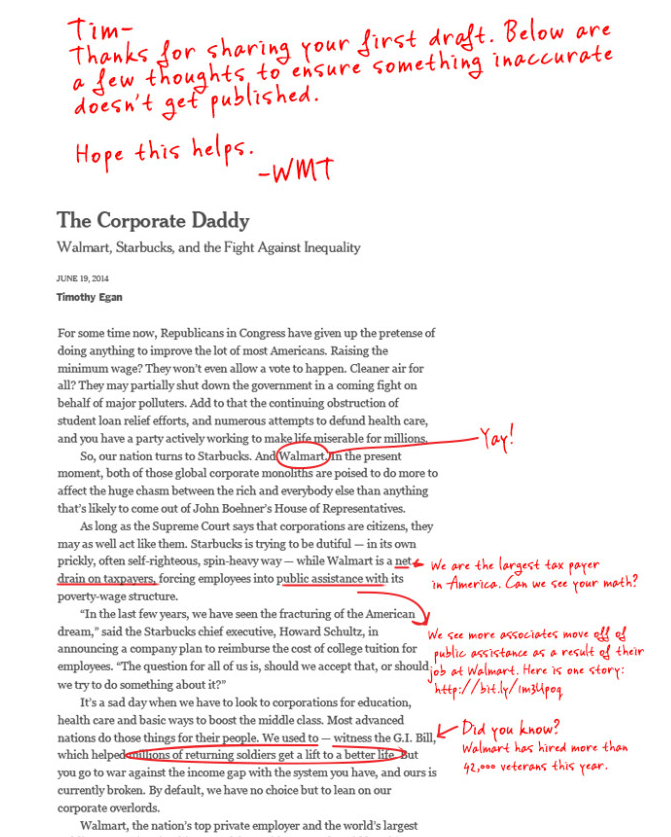Fighting Back Against False Media Stories: Two Examples
In The Media Training Bible, I included a lesson called “Three Things To Do When You’re Falsely Accused.” One of my recommendations was to consider offering your own proof to rebut a reporter’s incorrect claims:
In some cases, there is a place for harder-edged tactics…That means you might hire a private investigator to look into the background of any accusers or conduct a “parallel” investigation to uncover facts that your critics aren’t finding—or are purposely ignoring.
I’ve seen two memorable examples of this recently—one conventional, the other more inventive.
Example One: North Carolina Governor Attacks The Press
Last month, North Carolina Governor Pat McCrory accused The Associated Press of “malice” for its reporting about a stock payout he received from a company on whose board he once sat. (The AP stands by its reporting.)
That type of rhetoric isn’t particularly unusual—many politicians attack the press as often as they brush their teeth. But as WRAL.com reported, what made this attack stand out was “an eight-point refutation of the story and a 34-page critique of the reporter’s prior work.”
Among other points in his eight-point critique were these:
AP CLAIM: “However, more than a dozen securities lawyers and ethics experts told The Associated Press that such stock payouts are uncommon for elected officials, and raise significant concerns. These experts gave differing opinions about whether laws were broken.”
WHAT THE AP LEFT OUT: What “securities lawyers” and what “ethics experts?” Name them. Not one “expert” was named.
AP CLAIM: “AP reported that McCrory, a Duke retiree, held stock in the company as his administration made key regulatory decisions involving his former employer. Those decisions are now the subject of a federal criminal investigation.”
WHAT THE AP LEFT OUT: This is an outrageous accusation and this is absolutely incorrect – it is a false statement and was printed and published with malice. The AP is saying that the governor is under federal investigation and that is 100% false. Neither the governor nor anyone he hired has been subpoenaed as part of this investigation.
I don’t know the facts of this case well enough to form an educated opinion about who’s right—and I suspect the same is true for most readers. But this gets to another of the three recommendations I made in my book about defending against (what you believe to be) false charges: “Be ‘super’ open: The media tend to perceive those who talk as innocent and those who don’t as guilty.”
Sure, being this aggressive can be perceived by some as a form of defensiveness. But when compared to other potential responses—such as a “no comment” and a refusal to engage with the press—this is a far superior approach.
Example Two: Walmart Responds to The New York Times
Walmart used a cheekier response last summer to rebut a New York Times column with which it disagreed. The response itself—an annotated version of the original column—was admired by some and loathed by others. Personally, I thought its originality put a more creative and attention-grabbing spin on rebutting false narratives.
These aggressive responses can be a high-wire act, so they’re to be used judiciously and by PR professionals who can determine and manage the risks associated with them. But they can also be incredibly effective at muddying the waters by neutralizing a news article and leaving readers with the impression that there’s more to the story.
Don’t miss a thing! Click here to instantly join our mailing list and receive the best of the blog twice each month.





Hey Brad,
I really like how you compared this response to a high wire act. Especially in WalMart’s case, their snarky response to the article was full of red herrings (despite their one example of someone coming off social assistance – data would seem to indicate a high percentage Walmart employees continue to rely on assistance) and devoid of context.
Their response was practically begging for reporters and columnists to dig deeper and provide further analysis. Many of the articles debunking Walmart’s response were pretty harsh indictments themselves and only served to prove the Times’ initial point.
If I could suggest adding anything to your advice, it would simply be to make sure you/your company occupies the moral high ground before getting into scraps with journalists, who find things like contradictions, falsities and half-truths to be pretty newsworthy.